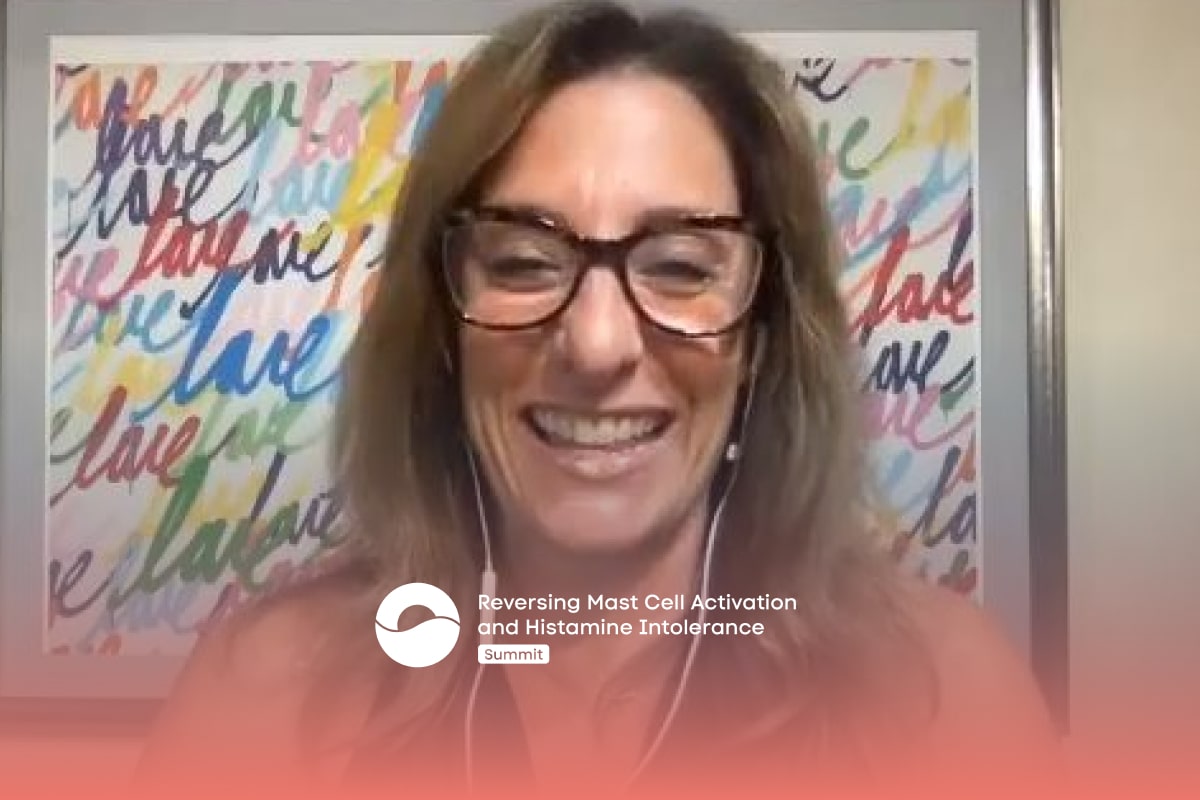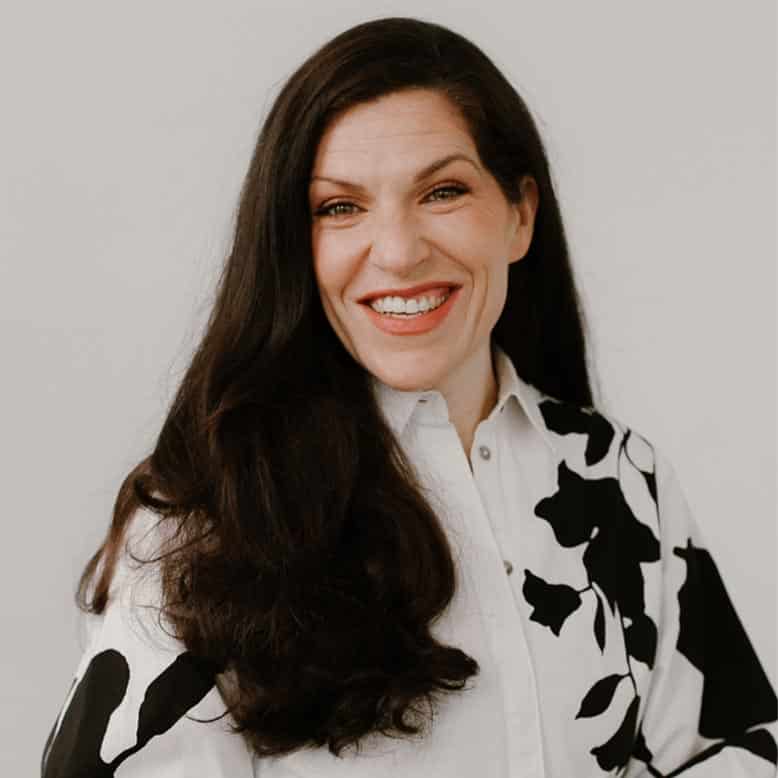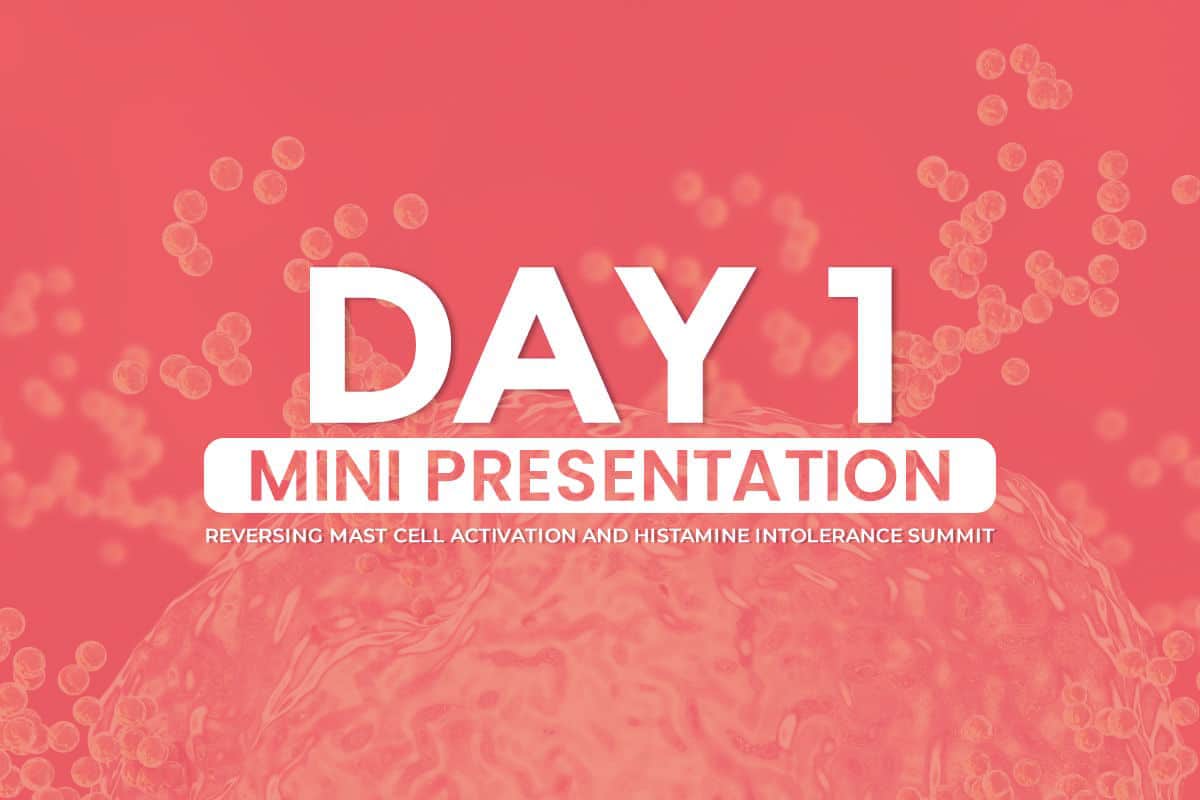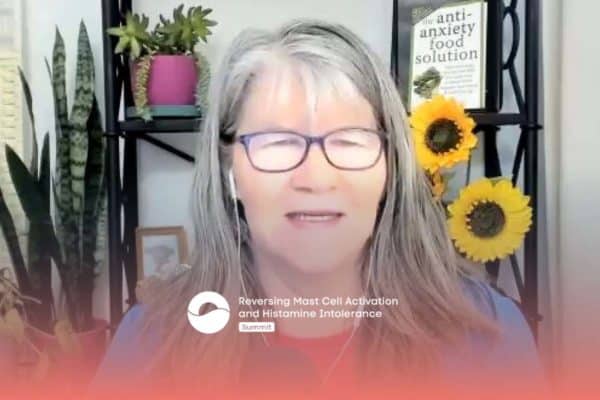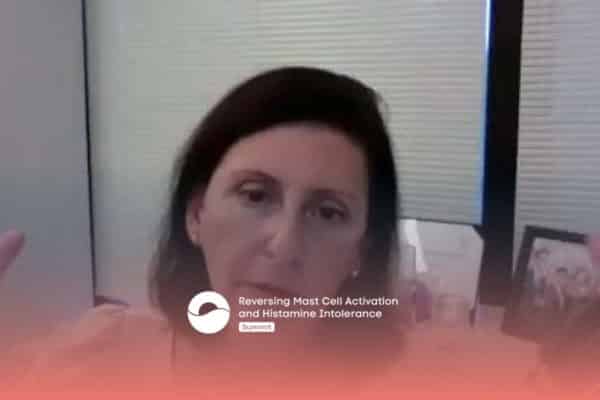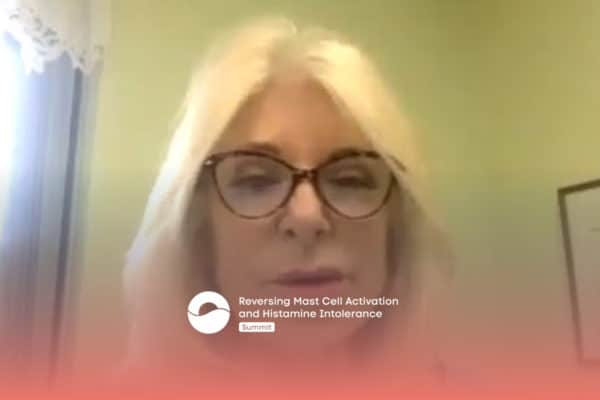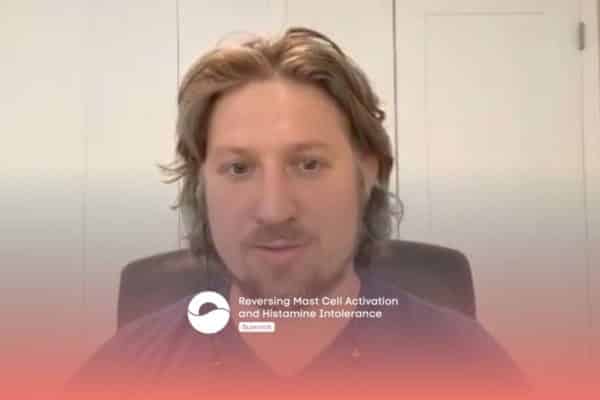Join the discussion below
- What is EFT/Tapping (emotional freedom technique) and how it can be helpful for people who are struggling with MCAS
- Discussion around unprocessed emotions and how they impact the way our body speaks to us
- Tapping…or demonstration of tapping for listeners
Christine Schaffner, ND
Welcome everyone to the Mast Cell Summit. I’m here with my dear friend and colleague, Julie Schiffman, and we’re gonna be talking about how to use EFT and tapping to help release stress and remain calm, especially when we’re dealing with such sensitivities. So welcome, Julie, it’s always an honor to talk to you.
Julie Schiffman, MSW
Thank you. Thank you for having me, so happy to see you today as always.
Christine Schaffner, ND
Oh, well we have worked alongside many patients together and after seeing your incredible work and it’s a huge piece to this puzzle when we’re working with chronically ill people. And I’m really happy that we’re having this talk in the Mast Cell Summit, because I think just as all of these talks are very important to understand the physiology and how to support the physical body. This is a key piece that I think that sometimes people think are an afterthought or maybe that’s like supportive, but they don’t really quite understand it. Like many of the root causes actually are in this layer and this, what we’re gonna be talking about. So I just want you to share a little bit about how you got into tapping and what are we like even talking about.
Julie Schiffman, MSW
So I’ve been tapping for over 25 years, I think it’s been at this point and it’s an amazing stress management tool and anyone can use it. It is quick, it’s effective. It’s beyond simple and it’s just so easy to use. And it’s something that anybody and everybody can use and it can help with just about anything and everything. So it can help with pain, it can help reduce stress. It can help to reduce blood pressure. It can help with brain fog. It can help with just, I mean, you name it, you think about it and it reduces cortisol. So it helps in so many ways and what it actually is. And then I’ll tell you how I got into this, but what it actually is is it looks like this. And so it’s a really gentle tapping, you can do it with two hands, you can do it with one hand. You can do it either side, it doesn’t matter, but it is a combination of ancient Chinese acupuncture and modern psychology that works to physically alter your brain, your body and your energy system all at the same time by tapping on these particular Meridian points.
So these are all just points that are connected to Meridian pathways in the body. And I’m sure most people watching this are familiar already with what that is. And so, what we’re doing when we’re tapping is we’re also talking about the pain or we’re talking about the stressor, or we’re talking about whatever it is that’s creating a challenge for us, okay? And the process of talking about it and tapping through it and accepting what it is that we’re going through allows this energy to move through us. Because what we know is that when we are struggling with an emotion or a pain, a challenge, an illness, whatever it is, if we’re not able to, if we don’t process what’s going on, if we don’t process our thoughts around it or our beliefs around it, or the emotions around it, then it can get stuck and stored in our body. And when that happens, then that’s when the pain gets bigger or that’s when mentally, emotionally, it becomes much bigger than it might actually be where we just become so overwhelmed and so frustrated. And so it is a tool again that I’ve been using for over 25 years. And my background, just to tell you is that I’m a social worker. I was actually at my master’s degree in social work, and I used to work in high school. And I’ll just give you a real brief background on this. But when I was working with students, I was starting to get panic attacks and like debilitating, horrible panic attacks. And so here I am trying to help students with anxiety or depression or challenges in their own life. And all I wanna do is like run out of the room.
I’m like just in a complete panic mode. And so obviously, I needed some help. And so whatever I went into therapy, which was great, but I also connected with a very dear friend of mine who does energy work and he wasn’t doing tapping or EFT. He wasn’t doing this, but he was doing other energy work and he was touching different points and he was muscle testing. And he was kind of showing me how emotions were blocking certain parts of my body and that I needed to like works through some things. And within a couple of sessions, only a couple of sessions. And prior to this, my father had passed away a few months earlier and I didn’t really process those emotions. And so, because those were sort of buried there, what ultimately ended up happening is that when we don’t listen to the symptoms, the symptoms that initially are little whispers, right? Small symptoms, when we don’t pay attention to them, they just get bigger and bigger and bigger. And so.
Christine Schaffner, ND
Yeah, I don’t know you went away and I don’t know if it’s me or you, but of course, it’s all good.
Julie Schiffman, MSW
I know.
Christine Schaffner, ND
So, we’re gonna just stop and then we’ll be edited where your father passed away and just start there, so.
Julie Schiffman, MSW
Okay, okay, then we’ll start again.
Christine Schaffner, ND
I’m just, I do think we’re curious, almost retrograde, so.
Julie Schiffman, MSW
Okay, I get it, the joys of technology.
Christine Schaffner, ND
Totally, so just where your father passed away, it’s a good break.
Julie Schiffman, MSW
So a few months earlier, my father had passed away and I didn’t really deal with those emotions. And we know that what I have learned over the years is that, initially it probably didn’t start out as panic attacks. There were probably very small whispers of different symptoms I was having, but I wasn’t willing to look at it or pay attention to it. And so it grew and it grew and it grew. And the thing about anxiety is that it wants to be heard. I mean, we know that it definitely wants to be heard and it will get louder until you listen to it and understand it. And the same goes with physical symptoms for us. And so fast forwarding, I ended up getting it connected with Dr. Mercola, who I know you are familiar with. And I worked for him for over 15 years and the way I started with him was he was like, I’m looking for someone he’s like, I can tell people what foods to eat and what supplements to take and the exercise and the water and the food intake and all of that is like, I could teach people all of that stuff. But what people don’t understand is that emotions play a very huge part in healing and what goes on in the body.
And so he said, he told me, he had heard of emotional freedom technique, also known as tapping. And he said, I want you to go and learn everything about it, and then come back and work for me. And so I quit my job at the high school and I started working for him. And I was like, this tapping thing was the craziest thing I had ever seen. People looked at me like I had three heads. And like, what, like you just tap on yourself, you just touch on yourself like this, and all of a sudden, all my problems are gonna be better? But the bottom line is yes. I mean, it’s like actually fascinating and it never ceases to amaze me when people are like, you’re not gonna believe this, but I don’t feel that pain anymore. Or I can’t even believe this, but that brain fog has just gone away, it’s just lifted.
And I mean, I just hear it over and over and over and over again. And I’ve seen thousands and thousands of clients, within a 25 year timeframe. And so after learning that, I mean, I never looked back to, even though there’s a good place for traditional therapy, of course, I mean, I highly recommend therapy, but as you and I were talking about before, I think that every therapist, every practitioner should have these energy modalities as part of their toolbox, because one of the great things about tapping is that you can use it on your own. A lot of the things you have to wait to go and see your practitioner, Tuesday at one o’clock and that’s all fine and good. I mean, we all need our helpers and healers around us and to help us. But one of the great things about tapping is that it can take just a few minutes to relieve stress, to relieve tension, to feel better in our body, to feel better in our mind, feel more content. And so I am a huge, huge, huge supporter and cheerleader of tapping, as you know.
Christine Schaffner, ND
I love it, I love your story and that personal experience, right? It just helps us to relate and share this from the mountaintops even more right when you have these personal experiences. And obviously, it created the career path that we’re so blessed that you chose. So there’s a few things to touch on here. I loved what you said, and I think it’s an important, especially, ’cause it’s so counter to kind of the mainstream paradigm of how we look at symptoms and health. Like the more that we try to kind of suppress things, the louder they get. I thought that was really brilliant and anxiety is something really common in our patient population. And I think it’s natural, that anxiety, not only from the experience of being sick, but often whatever led to them being sick in the first place. So I just wanted to present that ’cause in modern day, we do a lot of things to like, okay, how do we turn it off or shut it down or compartmentalize? And I just want people to know who are listening that it’s so like when you have the right support around you to really express and feel and allow these things to move through you and out of you, like this is where things get unblocked and start to flow. So I just wanted to like pick that out, ’cause it’s so important, anything to add or any other like anecdotes around that. But I think that it’s just, again, we have a lot of education I think, to do still about how to look at symptoms.
Julie Schiffman, MSW
Absolutely, well, I think the one thing, and it’s such a good point, right? That you bring up and I think, what gets lost people get so stuck in their symptoms and they get stuck in the story of the symptoms. I mean, I think that part is just so huge. They get stuck in the story of it and it’s understandable, anyone who’s dealing with a chronic illness, with chronic pain, it’s hard not to, right? Because you wanna sort of head it off before it happens. Like you wanna avoid getting the symptoms. And so, you sort of create this whole different world for yourself so that you can sort of avoid that. But underlying that, I think some people don’t really think about the underlying emotions with that. And so people, again, dealing with chronic illness, chronic pain, that sort of thing, these are people and people who are listening, you all understand, right? You have lost that part of you, maybe that used to be energetic, that part of you, that used to be hardworking and you could just get up and go or you could get up and exercise or you could get up and go to a party and go out for dinner with your friends.
So there is a part of you that misses who they used to be. And then there’s a part that probably feels really isolated because with people who suffer again with chronic illness, people don’t really understand, especially if they quote unquote look okay, because a lot of people present as you and I as just looking fine or looking healthy. But inside, they’re in pain and they’re dealing with sensitivities and they have a ton of anxiety. They are tired of not having energy. They are maybe in constant pain or constant discomfort and not knowing what symptoms might set them off. And so these thoughts that are constantly going through their heads is creates a stress in and of itself, which is so big, it’s so big. And that’s really where tapping comes in, tapping may not quote unquote, cure everything. It might not be the actual cure, but what it does is it helps to alleviate some of that stress. It takes that burden off. And when you’re able to step back from the stress and take a step back from the story surrounding it, then you start to feel better. We obviously stress and physical discomfort are very closely associated. So when we’re under a great deal of stress, symptoms can definitely be exacerbated and get bigger and bigger and bigger. And so if you can find a way to reduce the stress, then why not just try it and see how it works for you? It just, it works so well for that. Yeah.
Christine Schaffner, ND
Yeah. There’s a really low risk to try this.
Julie Schiffman, MSW
Very low risk, yes.
Christine Schaffner, ND
All the other things that we ask patients to do.
Julie Schiffman, MSW
Right, exactly.
Christine Schaffner, ND
Absolutely, so this is just like really a safe thing to try with such a profound potential for a reward. And I love how you also preface this. It’s not a quote cure, we’re always looking for those magic bullets and really how I’ve been trained and how I really think we need to look at the body, is that our job is to know and trust of course the innate intelligence. So the body knows how to heal, but we have to facilitate it and allow how to remove these layers of stress. So the body can self regulate the heal when it gets outta balance. And so it’s really, even those, these things are really complex. It’s really simple at the same time, you know? So this is a huge, huge piece. Anything to add to that before I ask you?
Julie Schiffman, MSW
Well, no, but I was just gonna, just jumping on that. I was just gonna say kind of as we mentioned before is you can give people, you as a doctor can give people a protocol and say, it’d be really important. It would be smart if you take these supplements and get this sort of rest and eat these foods definitely stay away from these foods and that sort of thing. And so people can look at their list and say, okay, I need to take this supplement, I need to take this herb. Or I need to do this at this time. I need to go to bed a little earlier, right? So they can look at their list and they can kind of say, these are the things that I can do and check off my list that will be helpful to me. And the one thing I think most people don’t understand for themselves even is, how do emotions even fit into this? Like how do I even begin to look at the emotions? Like I don’t even know where to start with this. I can’t even think straight, how can I even begin to look at what the emotions are and where to go with this? Like it just might seem so overwhelming. The other stuff might seem a little bit more simpler, even though it might seem challenging or hard in some way to change diet and to add things in and to create more of a protocol that might seem like a challenge to people understandably, right? When you have to change your life so much, but the emotional piece of it is also such a big piece. And understanding how to add that in for yourself is really important.
Christine Schaffner, ND
I love that. I think that’s such a great suggestion and will do a tap exercise at the end that people can experience and have in their toolkit and will share also Julius done so many videos on YouTube for you to check out. But I love that because that’s so true. Like, I mean, and I just having a light bulb moment, I’m like, I should just make, even before they maybe see a practitioner, like you just have patients, start to get to know this modality and give them like, just like brushing your teeth, you’re gonna be tapping, you know? And so, and that’s an introduction and the body can start gently nudging. And I also think too that we say a lot of us who do this work, the issues are in the tissues, right? And so, we get so focused about, okay, talking about mass cells, right?
Julie Schiffman, MSW
Okay.
Christine Schaffner, ND
All the things that trigger and all the things that stabilize things and how to reduce toxicants and pathogens and all of these physical things that are really of course, important and part of the equation. But we often, forget, or maybe don’t give it the importance of it needs is that, really there are things called fascial memory and emotions, that would be a whole nother lecture, but there is emotional imprints stored in the fascia and the connective tissue and in the physical body. And so as you move these physical things, you are tapping on the door of emotions, whether you like it or not, that are stuck that’s and these tissues, and then there’s like this whole, other of course, world that I think needs to be explored about how emotions, right, we know through psycho neuro immunology are probably also communicating with math cells in a way that we probably still have to learn, or maybe I just haven’t gone down that rabbit hole and studying enough. It’s probably matter fingertips to know that this is just as important as taking your oxygen, you should have this. So I think it’s, I really appreciate the education you’re sharing.
Julie Schiffman, MSW
Yeah and it’s interesting. And I learned this not that long ago actually, is that the life of an emotion, like from beginning to end is actually 90 seconds. And I was like, shocked to hear that the life of an emotion is 90 seconds, but what happens within that 90 seconds is sometimes we can just say, oh, this makes me sad. And then, we can sort of move on from it, but when we attach a story to it, so we start, number one, we start ruminating about the emotion, right. So let’s just say we’re feeling angry or frustrated or that sort of thing. You know what happened outside of us that made us feel that way. And then we start to create a story around it, right? So whether it’s about what somebody else did or whether it’s about the fear that someone is feeling about what’s going on in their body and how can I stop this? Like, oh my God, this feels terrible. I have this terrible brain fog, or I’m getting this bad pain in my arms or my fingers or whatever. And I’m not gonna be able to do this, or I’m not gonna be able to lift my children or my grandchildren, or I’m not gonna be able to go to have dinner with my friends tonight or that sort of thing.
And so a story and beliefs, right, it starts to, the whole thing starts to get created where we start thinking over and over and over again. And then it becomes bigger and bigger and bigger and bigger. So this 90 second emotion, this life of this emotion that really could be only 90 seconds could turn in days, right? Because if we don’t process it, if we don’t learn how to process it and move it through, then it has no choice. But I mean, emotions are just energy, right? Emotions are energy in our body, we have a thought, it creates a feeling in our body. And then that goes back to more thoughts, but it just can get bigger and bigger and bigger. And when it lands somewhere in the body and whether it be in the fascia, whether it be in our ligaments, whether it be in our cells, whether it be in an organ, a gland, a chakra, whatever it is, if we don’t process it, then it’s kind of what we talked about earlier is that it’s just gonna get bigger and bigger and bigger until you have no choice, but to listen to it.
And so with a tool like tapping, obviously there are great tools out there, right? There’s meditation and there’s all sorts of things that we can do to help ourselves to feel better. Tapping just happens to be one that I think is amazing and that it can be relatively quick. And it’s more frenetic if people don’t like to just be quiet, but I lost my train of thought there anyway. So, if we’re able to look at how am I feeling right now, I’m feeling angry about this. I’m feeling frustrated about this. And so if you can take a moment and do some tapping on it and create the shift right then, then it has nowhere to go, then it’s done, then you’ve moved it through and it’s gone. And ultimately it’s what I call a win-win because not only are you winning in the sense of, it feels better emotionally and mentally to you, but it also starts to feel better in your body. You start to notice that you are feeling more relaxed and more calm in your body. And so it’s a, win-win all around.
Christine Schaffner, ND
Yeah, I love that. And when you say, I mean, that’s new to me too, that an emotion has a 90 second life span. I think of a two year old might being a four year old and seeing then explosion emotion.
Julie Schiffman, MSW
Yes.
Christine Schaffner, ND
This explosion and then hopefully move through it, in 90 seconds. But I, we can see that right in our kiddos and then they shake it off and move along.
Julie Schiffman, MSW
Yes.
Christine Schaffner, ND
So I think that’s really quite brilliant to know that and that is such an empowering story, ’cause I think we can think that these things are, we just are destined to feel this way or we’re gonna just perpetuate, feeling angry or anxious, forever when we have a lot more ways into with these tools, ways to shift that and not say stuck in that. So I think it’s a lot of our work is helping unstuck people. So it’s very technical term, so.
Julie Schiffman, MSW
Right, get unstuck, it’s funny. I was just thinking about a client who not long ago and she’s been dealing with a lot of chronic stuff, a lot of, not maybe nit mass cells specifically, but just dealing with a lot of chronic things in her body. And one of the things has been more digestive stuff, IBS and bloating.
Christine Schaffner, ND
Bloating.
Julie Schiffman, MSW
Yes bloating, a lot of bloating and in constipation, that sort of thing, a lot of inconsistencies. So anyway, we were doing some tapping around it, because she was like, she actually eats really well. Like she eats impeccably better than I think most people I’ve ever met. Like she is really impeccable with her food. And so she can’t, so I think it’s harder for people to understand. They’re like I do do everything I’m supposed to do, everything they’ve told me. And she’s like, but I just can’t seem to move through this. And so in talking about it, well, when did this start? Well, it started when I had children like 12, eight years ago, I think eight years ago it was something like that. All right, so let’s talk about that for a minute. What was that like? It was after her last child was born and let’s talk about what that was like for you. And she starts like whispering, it’s a Zoom call and she starts whispering. And she was like, actually I have some regrets about it.
And her kids were like around probably or something. And so I’m like, okay, let’s talk about that. And so because she didn’t really, I mean, she knew that it started after she had kids, but has never really, she had a lot of shame around having some regret. She loves her children absolutely more than anything in the world, but it changed her life in ways, obviously that we all know anybody who has children understands, it just changes life, right? And so there was, she was on a different path and I think she was only planning on having one child. She wasn’t planning on having the second one and it was a surprise. And anyway, again, loves her kids. But the bottom line was that she had some regrets about things that she wasn’t able to do and how it changed her life and whatever. And so in doing, in addressing those emotions again, she was not, she had so much shame around it that she didn’t share it. So this is all thoughts and emotions that became trapped in her body because she didn’t, she would never tell like her husband, she wouldn’t tell her friends because that made her seem like she would be a bad parent, that she would be a bad mother for saying these things out loud, which isn’t true.
But then by voicing it and tapping on all the feelings around it, right? All the regrets, the frustrations, whatever the emotions were that came up around it, the sadness, all of that, she couldn’t digest the changes in her life, all of that. And so she, then once she addressed all of that, she was then able to notice changes were happening, suddenly, she wasn’t so bloated anymore. And suddenly she was digesting her food differently. And suddenly she was able to move bowels and she was able to, all of those things. And so that’s like a perfect example of how emotions play such a big part in what’s physiologically is going on in our body and once she addressed it and now she’s like moving on, moving forward with her life in a way where she can appreciate her life, appreciate her children. And you have some forgiveness for herself and for things that happened in the past, move on, move forward and start digesting.
Christine Schaffner, ND
I love that, I love that story. And I think that illustrates this idea of having to be perfect and we still have symptoms and the Mast Cell World too, it’s like, understandably, because people have been traumatized and there’s so much fear this idea. If I control my environment and I avoid all my triggers and I really do what I can to feel empowered because it’s obviously very painful to go through these experiences, but people still react even with controlling their environment to the greatest extent. So I really think again, if you’re listening out there and you’ve tried everything and you’re still not getting the results, this is a huge, huge, huge area to explore. So I’m so excited for all the people who might have a light bulb right now. So Julie, tell me about these patients that we’re talking to are highly sensitive, right?
Julie Schiffman, MSW
Yeah.
Christine Schaffner, ND
For all the reasons and they’re, obviously we look at sensitivity too, when people are highly sensitive that there’s an energetic sensitivity that they may or may not be aware of, right? And so there are patients who have reported even like tapping on their physical body on these meridians actually flares them. And so, have you experienced that? Is there anything that you can make sense of and then how do we like get people to start tapping even when they’re in that really sensitive state?
Julie Schiffman, MSW
Absolutely, so I definitely have had clients over the years that have had those sensitivities and the beautiful thing about tapping is that you don’t necessarily have to be tapping like this. So there are a couple different things that people can do and that people have found to be really helpful. And it’s all energy, right? It’s all based on energy. It’s based on intention as well. And so if you are someone who is sensitive and this feels really sensitive, or it feels like it’s on fire, or it just feels like this is really painful, there are a couple different things that you can do. So one of those things is you can touch, you can touch these points, so you don’t have to tap, you can touch and you can just, you can even just touch and breathe. And so if that feels good to you, that’s something that you can do. You can just keep moving the fingers. If you don’t wanna keep moving the fingers, you can just, if there’s one point that feels good. A lot of times this is a point that feels good to people or even, there’s a collarbone point right here.
Yep and so people can just put their fingers there and breathe, you can do that or so you don’t necessarily have to be tapping, okay? And that can be really calming, really soothing for people. Another thing that people can do is you can put your fingers above the points. And so, you don’t necessarily have to even make contact with the points. So what I’m doing here is I’m just holding it like, right, I’m holding it like above like that. I’m not actually touching it. So I’m like an inch away, maybe a few centimeters away and you can’t move your fingers like this. And if you do that and you pay attention to it, you can probably feel the heat even, you can feel the heat from your fingers there. And so, that that energy is still making contact, even though you are not actually tapping like this. And the last thing that you can do. And one thing that I highly recommend for people who have a hard time sleeping at night is you can close your eyes and just imagine yourself tapping, we call it, imagine tapping or tapping, something like that. And so you can actually close your eyes or keep ’em open, whatever you choose.
But if you’re having a hard time sleeping, it’s a great way to do that. And so you just imagine that you’re touching these points, so it doesn’t have to be for sleep. It can be for anything, but just imagining it, that can also, again, sort of activate the energy moving in your body. So these are a lot of different ways. Tapping is super forgiving in that you can do it. I mean, you could tap like probably back here or like on your leg somewhere. I mean, you’ve got these meridians all over your body, the points that are initially labeled as tapping points are just, they’re all connected to while they’re meridians. So they’re all connected to different organs and different glands and that sort of thing. So it sort of opens that up and makes that connection, but you can get any energy moving in your body in any way, shape or form. So those are all really good ways to use tapping. That’s not necessarily actually tapping.
Christine Schaffner, ND
I love that, I think that gives people a lot to work with. And as people do this more, I think their sensitivity will decrease and they can even, eventually get on the body and do the tapping. But this is of course, I love that there’s so many options. So tapping is for everyone, truly.
Julie Schiffman, MSW
It really is. Tapping really is for everyone. We say, try it on everything because everyone and everything, even babies, you can use it on babies. I’ve used it on my dogs. I mean, you can really, it’s just a stimulating, you’re just stimulating something. But instead of it being stimulating in the sense, that’s like, wow, although you might want to tap for feeling like that, if you’re feeling tired, but more or less what it does, is it neutralizes, it neutralizes your thoughts, it neutralizes your emotions so that you have like a, you’re just feeling calmer. You’re feeling more relaxed, which, who doesn’t wanna feel like that?
Christine Schaffner, ND
I know, totally, totally.
Julie Schiffman, MSW
Yeah.
Christine Schaffner, ND
All throughout the day, even when I see patients, I’ll even just tap myself to clear energy or just, I love the thymus point. Me too is not necessarily tapping routine, but I’ve always like.
Julie Schiffman, MSW
The thymus thump, yeah.
Christine Schaffner, ND
Okay, life is good.
Julie Schiffman, MSW
Yeah, that’s right. Breathing it in, yeah it’s great.
Christine Schaffner, ND
So, I love it. Well, I think we’re a good place to do some tapping if that sounds good. And then again, Julie just shared, if you’re sensitive out there, if you’re new to this, please listen to your body and just take it easy and take it slow. And I think either finding a point to just rest your hands and just use your mind to go through the process or using the hovering method would be a really great start of someone’s concern out there.
Julie Schiffman, MSW
Absolutely, absolutely.
Christine Schaffner, ND
That sound good and we’re gonna dive in.
Julie Schiffman, MSW
Yeah, let’s dive in. So I’m thinking, I think most people understand out there what it feels like to be stressed and to have these symptoms or pains or sensitivities in their body. And so what I would ask everyone to do is just tune in. Obviously everybody’s different. Everyone has their own emotions and their own feelings around this, but my guess is that everyone understands the feeling of frustration around what’s happening in your body and the way your body’s speaking to you, because that’s really ultimately what’s happening, right? Is your body speaking to you with sensitivity or with pain or discomfort or that sort of thing. So just connect with all of that. And when you’re ready, we’re gonna tap through the point. So I’m gonna ask you Christine to just be my echo as we go through it. So just repeat after me, okay? Thank you. And again, for anyone else, if you don’t wanna actually tap, just rub, go ahead. Something like that or just touch, okay? But we’re gonna tap ’cause this is the actual act of tapping. Okay, so even though my body’s really speaking to me with these symptoms.
Christine Schaffner, ND
Even though my body is really speaking to me with these symptoms.
Julie Schiffman, MSW
And I feel frustrated.
Christine Schaffner, ND
And I feel frustrated.
Julie Schiffman, MSW
Scared.
Christine Schaffner, ND
Scared.
Julie Schiffman, MSW
Where is this heading?
Christine Schaffner, ND
Where is this heading?
Julie Schiffman, MSW
I honor and accept myself.
Christine Schaffner, ND
I honor and accept myself.
Julie Schiffman, MSW
And my body.
Christine Schaffner, ND
And my body.
Julie Schiffman, MSW
And I’m open to shifting this now.
Christine Schaffner, ND
And I’m open to shifting this now.
Julie Schiffman, MSW
Even though it may be hard to love and accept myself.
Christine Schaffner, ND
Even though it may be hard to love and accept myself.
Julie Schiffman, MSW
When I’m not feeling good.
Christine Schaffner, ND
When I’m not feeling good.
Julie Schiffman, MSW
When I’m feeling sick.
Christine Schaffner, ND
When I’m feeling sick.
Julie Schiffman, MSW
Tired.
Christine Schaffner, ND
Tired.
Julie Schiffman, MSW
Dizzy.
Christine Schaffner, ND
Dizzy.
Julie Schiffman, MSW
Hard to concentrate.
Christine Schaffner, ND
Hard to concentrate.
Julie Schiffman, MSW
It’s hard to accept myself.
Christine Schaffner, ND
It’s hard to accept myself.
Julie Schiffman, MSW
But I’m open to accepting where I am now.
Christine Schaffner, ND
But I’m open to accepting where I am now.
Julie Schiffman, MSW
I am ready and willing to heal.
Christine Schaffner, ND
I am ready and willing to heal.
Julie Schiffman, MSW
At my own pace.
Christine Schaffner, ND
At my own pace.
Julie Schiffman, MSW
And we’re gonna tap through the point so you can tap on the top of your head. My body’s really speaking to me.
Christine Schaffner, ND
My body is really speaking to me.
Julie Schiffman, MSW
And tap over the inner eyebrow, just on the corner there. My body’s speaking to me with pain or tension.
Christine Schaffner, ND
My body’s speaking to me with pain or attention.
Julie Schiffman, MSW
And on the side of your eye, this discomfort in my body.
Christine Schaffner, ND
This discomfort in my body.
Julie Schiffman, MSW
And under your eye and all this sensitivity.
Christine Schaffner, ND
And all this sensitivity.
Julie Schiffman, MSW
And under your nose, I’m sensitive to everything.
Christine Schaffner, ND
I’m sensitive to everything.
Julie Schiffman, MSW
And on your chin. And I always have to be on guard.
Christine Schaffner, ND
And I always have to be on guard.
Julie Schiffman, MSW
In the collarbone, trying to stay two steps ahead.
Christine Schaffner, ND
Trying to stay two steps ahead.
Julie Schiffman, MSW
To avoid the discomfort.
Christine Schaffner, ND
To avoid the discomfort.
Julie Schiffman, MSW
And the activation of symptoms.
Christine Schaffner, ND
And the activation of symptoms.
Julie Schiffman, MSW
And tap onto your arm and that’s a lot of hard work.
Christine Schaffner, ND
And that’s a lot of hard work.
Julie Schiffman, MSW
It’s exhausting.
Christine Schaffner, ND
It’s exhausting.
Julie Schiffman, MSW
And on the top of your head and it’s possible that no one really understands what I’m going through.
Christine Schaffner, ND
And it’s possible that no one really understands what I’m going through.
Julie Schiffman, MSW
And over your eyebrow. And that’s frustrating too.
Christine Schaffner, ND
And that’s frustrating too.
Julie Schiffman, MSW
And the side of your eye, all these feelings.
Christine Schaffner, ND
All these feelings.
Julie Schiffman, MSW
And under your eye, all these emotions.
Christine Schaffner, ND
All these emotions.
Julie Schiffman, MSW
And under your nose, I’m open to finding some relief in this.
Christine Schaffner, ND
I’m open to finding some relief in this.
Julie Schiffman, MSW
And tap on your chin, I’m open to forgiving my body.
Christine Schaffner, ND
I’m open to forgiving my body.
Julie Schiffman, MSW
And the collarbone, for all these symptoms.
Christine Schaffner, ND
For all these symptoms.
Julie Schiffman, MSW
And under your arm. But I want my body to know.
Christine Schaffner, ND
But I want my body to know.
Julie Schiffman, MSW
And on the top of your head, that I’m listening.
Christine Schaffner, ND
That I’m listening.
Julie Schiffman, MSW
And over your eyebrow, I’m finally listening.
Christine Schaffner, ND
I’m finally listening.
Julie Schiffman, MSW
And on the side of your eye and I’m choosing to be here for me.
Christine Schaffner, ND
And I’m choosing to be here for me.
Julie Schiffman, MSW
And your eye, having patience and compassion for myself.
Christine Schaffner, ND
Having patience and compassion for myself.
Julie Schiffman, MSW
And under your nose for once, for once.
Christine Schaffner, ND
For once.
Julie Schiffman, MSW
And on your chin, I tend to be very hard on myself.
Christine Schaffner, ND
I tend to be very hard on myself.
Julie Schiffman, MSW
And the collarbone and the way that I’m feeling.
Christine Schaffner, ND
In the way that I’m feeling.
Julie Schiffman, MSW
And under your arm. I’m so grateful for the ability to let it go.
Christine Schaffner, ND
I’m so grateful for the ability to let this go.
Julie Schiffman, MSW
And on the top of your head, I’m releasing this frustration from all the joints in my body.
Christine Schaffner, ND
I’m releasing this frustration from all the joints in my body.
Julie Schiffman, MSW
And over your eyebrow, from all my organs in my glands, in my body.
Christine Schaffner, ND
From all my organs and all my glands in my body.
Julie Schiffman, MSW
And the side side of your eye, I am releasing it from the fascia in my body.
Christine Schaffner, ND
And releasing it from the fascia in my body.
Julie Schiffman, MSW
And under your eye, in my cells and lymphatics.
Christine Schaffner, ND
In my cells and my lymphatics.
Julie Schiffman, MSW
And under your nose, I’m releasing and letting go from my circulatory system.
Christine Schaffner, ND
I’m releasing the letting go from my circulatory system.
Julie Schiffman, MSW
And on your chin and my immune system.
Christine Schaffner, ND
My immune system.
Julie Schiffman, MSW
In the collarbone, I am sending peace and love to all of my cells.
Christine Schaffner, ND
I’m sending peace and love to all of my cells.
Julie Schiffman, MSW
Feeling calmer and more relaxed in my cells.
Christine Schaffner, ND
Feeling calmer and more relaxed in my cells.
Julie Schiffman, MSW
And your arm, feeling this wave of calm, come over me. I am feeling a wave of peace and calm come over me.
Christine Schaffner, ND
I’m feeling a wave of peace and calm come home for me.
Julie Schiffman, MSW
And just tap your wrist together and say, peace.
Christine Schaffner, ND
Peace.
Julie Schiffman, MSW
Good, take a big deep breath in and let it out. And then you just wanna see how you feel, right? How does that feel? Hopefully it’s calming, it’s peaceful. People can go back and do it again. They can go ahead and tap along with some videos. They can find their own words. That’s what’s so important is to be specific and see what comes up for you when you go through that process, right? That we brought up a few different things there, right? The frustration and the way your body’s speaking to you and that people not understanding, so what comes up for you around that? And then you wanna go back and address it.
Christine Schaffner, ND
Yeah, I just love how gifted you are with saying the exact right words that I know so many people need to hear and know we certain the energy, but it’s perfect.
Julie Schiffman, MSW
I think so, right?
Christine Schaffner, ND
It was like at the calm I’ll be like, oh, you know?
Julie Schiffman, MSW
Right.
Christine Schaffner, ND
So…
Julie Schiffman, MSW
Oh my God, I know.
Christine Schaffner, ND
Yeah, we’ll just, I’ll wrap this and then.
Julie Schiffman, MSW
Lets’ go ahead.
Christine Schaffner, ND
We’ll hold the energy for.
Julie Schiffman, MSW
Absolutely.
Christine Schaffner, ND
Here we go. But I just love how gifted you are with just channeling the right words that people need to hear. And I know that people who are listening can, hopefully, if you buy the summit, you can listen to the recording over and over again. I mean, get this into your routine. And I just hope that this serves so many people out there and you’ve done an incredible job, Julie, offering so much create information out there on YouTube.
Julie Schiffman, MSW
Thank you.
Christine Schaffner, ND
And you’re a very gifted practitioner and I know you’re booked out very far in advance, but I know everybody would be flooding to you if you have the space. And I’m very grateful that you see me and so.
Julie Schiffman, MSW
Thank you.
Christine Schaffner, ND
So if you could just share with everybody where they can find you and all of that great stuff.
Julie Schiffman, MSW
So they can find me on YouTube, Julie Schiffman, S-C-H-I-F-F-M-A-N. I have so many videos over a hundred. I don’t even know how many I have at this point, but there’s a lot and I’m always adding to it. So you can join me there. I’m also on Instagram, JulieSchiffman_TapIntoLife. And I am also on Facebook, Julie Schiffman EFT. So, and my website is julieschiffman.com. So those are all places where people can find me. And I encourage you to find me, follow me because I do have, I mean, I’m always so passionate about sharing the information for free so that people can really understand it and use it because I just want everybody to know about it and use it and just feel better in their body and feel better in their life. So I am fully committed to that.
Christine Schaffner, ND
Mm.
Julie Schiffman, MSW
So thank you for letting me share the message here as well.
Christine Schaffner, ND
Yeah, no, I really honor that and see that you, and just think of how much you have been part of this movement and getting out there. And 25 years you’ve been doing this.
Julie Schiffman, MSW
Yeah.
Christine Schaffner, ND
You’ve created a big ripple effect. So thank you for all that work.
Julie Schiffman, MSW
Thank you.
Christine Schaffner, ND
Make this available. So we’ll have all of that information alongside this interview and I’m so grateful Julie could be part of the Mast Cell Summit. So thank you so much for tuning in.

